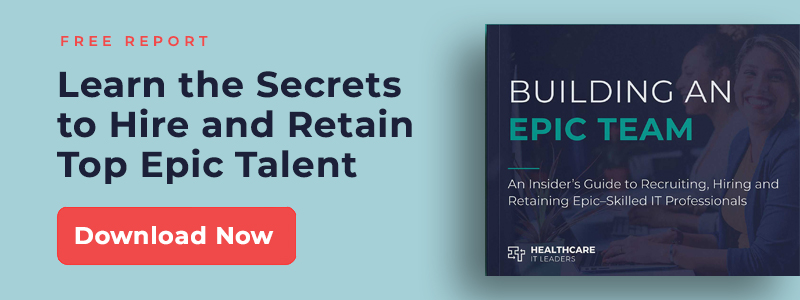Involve Providers Early and Often for EHR Implementation Success

While there are many “pieces of the puzzle” to a successful EMR implementation, in my experience as a consultant to several large-scale Epic projects, getting your Providers on board is most essential. This includes Physicians as well as the ever more utilized Nurse Practitioners and Physician Assistants. Incorporating the healthcare providers is one of the most important pieces and can be one of the most challenging.
Below are a few of what I consider to be the most important aspects of the road to success with your Providers.
Identify Physician Champion(s)
This is key and should be initiated early. Many times this Champion is someone who has a keen interest in technology and understands the value and importance of an electronic medical record. Other valuable qualities for a Champion include:
- Excellent communication skills
- Ability to make key decisions
- Influence with their peers
- A positive attitude
The Physician Champion will need to communicate well with their colleagues and be able to make key decisions by involving key stakeholders in the Provider arena. In order to drive this process, the champion must be influential and have integrity with their peers.
Hiring for an Epic implementation? Download our free guide.
While this process can become very challenging due to dealing with various personality types and egos, the Champion must be able to maintain a positive attitude and be a “cheerleader” for the implementation.
Involve the Providers in the beginning
A common mistake in many implementations is that the Providers are not involved until much later in the timeline of an EMR roll out. This leads to miscommunication and negative impressions of the system.
By involving them early you are most importantly demonstrating their value to the process and developing the key message that this is more than an IT implementation. This early involvement may include direct messaging through printed materials as well as the Physician Champion beginning to attend Specialty meetings on a monthly basis. Initially, simply providing key dates and plans will be important. As the timeline moves forward providing demos of key aspects of the system will be well received.
Develop a Physician Advisory Group
Tapping Providers in an advisory role is another form of engagement. One way of doing this is to bring together key providers from each sub specialty. These resources become early adopters and will begin to communicate back to their colleagues and can dispel rumors or misinformation that begins to develop with any implementation.
Use this group’s time wisely. Holding a monthly meeting for one hour in the beginning is enough. Discuss key decisions that need to be made that impact the Providers. Develop consensus among the group and have a vote on key decisions. The chosen should be able to go back to their specialty groups to communicate key information and begin to build excitement with their peers.
Demo Key Features
As the system is being developed, begin to demonstrate vital functionality. This can be accomplished in meetings or by setting up a mobile unit in the Physician Lounge or high traffic area.
Start by demonstrating something very simple such as ordering a medication or inputting of a patient history. As they begin to become familiar with the system, show more advanced functions such as medication reconciliation or building an order set. Don't hesitate to show system features while the build is ongoing. The more exposure you can provide for the providers prior to formalized training, the more comfortable they will become.
Develop Training by Specialty
Healthcare Providers are among the ones who will be utilizing the system the most and often times do not have the time or patience for training. Therefore it is of utmost importance to use this time as effectively as possible. If you do not have training materials and trainers who can speak their language and answer their questions, you will lose them very early.
Having the right amount of training with relevant information is a big investment for the healthcare organization. I can’t over emphasize the importance of investing in Training. It can make or break an implementation.
Training should be offered at various times and dates to provide alternatives for their very busy schedules. (For more on this topic, see this excellent post on EHR Training for Providers by my colleague Vicki Davis.)
Support Providers at Go-Live
The Go Live of any IT implementation can become a bit chaotic. Having resources available to support all staff is important but the Provider group is especially notable. The Provider is often moving back and forth between his/her office and the hospital setting. You must be prepared to have support staff at both locations to provide immediate help. Of course, if the training has been done properly, the support will go much smoother. Organizations will typically have “super users” who have had additional training. These super users will continue to support their end users weeks and months after go live.
Due to the importance and schedules of the Providers and the inability for many Physicians to take the time out of their busy schedules to become super users, many organizations will bring in contract physicians who specialize in go live support for Providers. This has been very successful as the support is peer to peer vs. simply any system expert communicating to a physician. This also shows the Provider that the organization is willing to make a big investment in their success.
While there are many other aspects of an implementation which are important, I have found the areas noted above to be of top priority for the Providers. Having your Providers on board is essential. Work through this plan methodically and have them at the table from the beginning and you will have a much more successful implementation.
Jeff Mason is Director, EHR Solutions. Prior to joining Healthcare IT Leaders, he supported clients in provider transformation, patient flow, and operational improvement as an Accenture Health consultant. Most recently, he served as the Provider Adoption / Clinician Readiness Lead for a large-scale Epic implementation in the Northeast.
